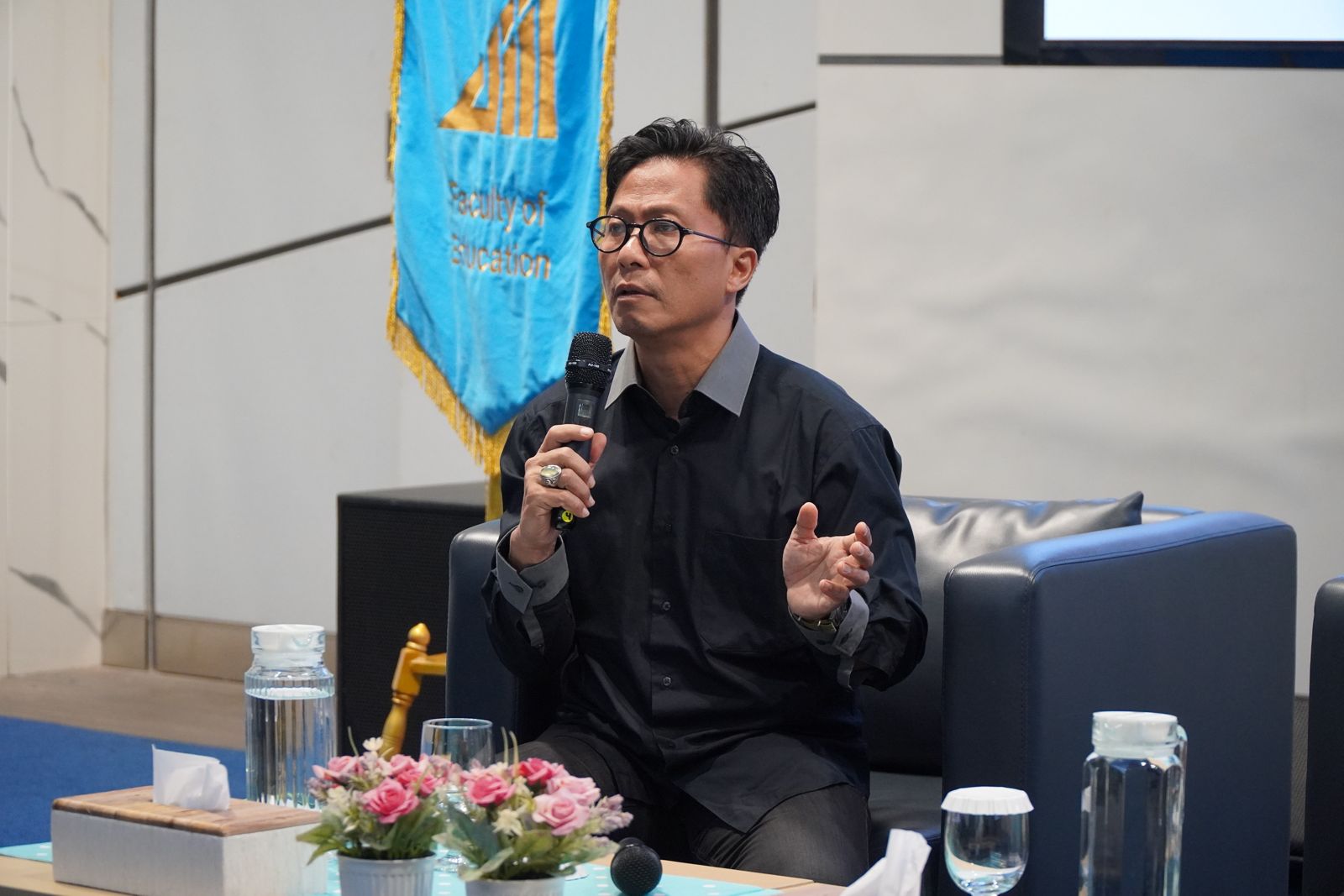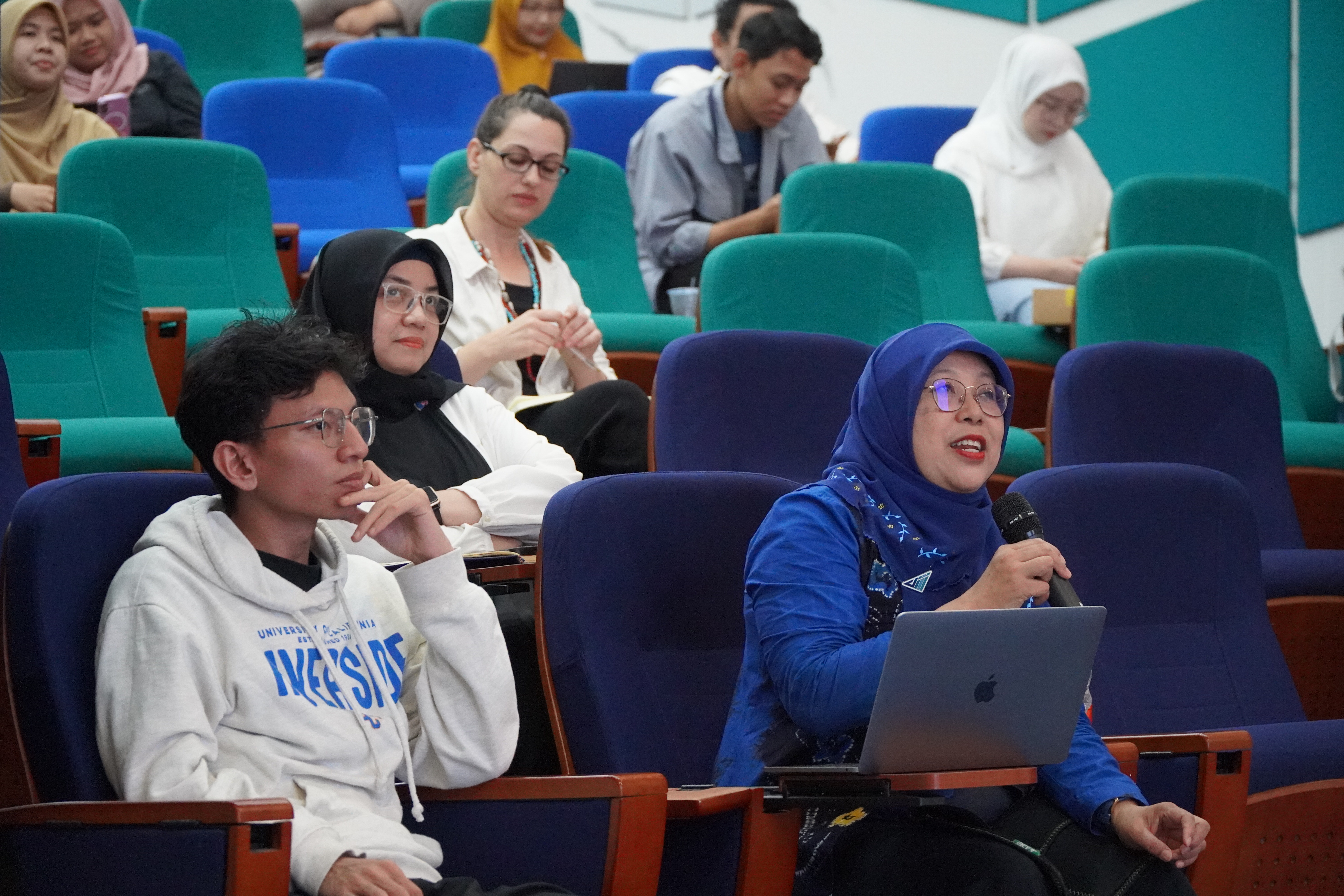September 29, 2025
Contributor & Photo by: Virda Lalitya Umam

The UIII’s Faculty of Education hosted its 44th LunchTalk on August 19, 2025, featuring Dr. R. Alpha Amirrachman, a distinguished lecturer at the Faculty with a presentation titled “Is America’s Education Empire Crumbling in the Shadow of China’s Rise? An In-Depth Analysis for Global South Opportunities.” His talk explored how shifting USA–China dynamics shape the global education landscape, with particular implications for the Global South.
Dr. Amirrachman began by comparing the two economic giants. In 2025, the US remains the world’s largest economy with a GDP of $28.5 trillion, though its growth has slowed to 2.3% (down from 2.5% in 2024). China follows with $19 trillion, posting a stronger 4.8% growth, largely driven by industrial and export strategies. In terms of research and development (R&D), the US currently allocates 3.5% of GDP while China invests 2.4%—yet projections suggest China will surpass the US by 2030.
 These foundations, he explained, directly influence education. The US still dominates global higher education, with 197 institutions listed in QS rankings and a longstanding reputation for creativity and innovation. By contrast, China produces scale: 77,000 STEM PhDs annually compared to the US’s 40,000, and it files more patents overall, although the US leads in “high-impact” patents and Nobel Prizes (over 150 since 2000). At the secondary level, however, China outperforms: 2025 projections show Chinese students leading in PISA scores (1605), far ahead of the US average (1454), which remains below OECD standards in math and science.
These foundations, he explained, directly influence education. The US still dominates global higher education, with 197 institutions listed in QS rankings and a longstanding reputation for creativity and innovation. By contrast, China produces scale: 77,000 STEM PhDs annually compared to the US’s 40,000, and it files more patents overall, although the US leads in “high-impact” patents and Nobel Prizes (over 150 since 2000). At the secondary level, however, China outperforms: 2025 projections show Chinese students leading in PISA scores (1605), far ahead of the US average (1454), which remains below OECD standards in math and science.
These economic foundations, Dr. Amirrachman explained, in turn, influence the respective nations’ educational approaches and metrics. The US still holds the lead in the global higher education scene, boasting 197 institutions in the QS rankings with many well-established names. For outputs, China produces approximately 77,000 STEM PhDs annually, compared to the US’s 40,000, and files more patents overall, though the US still leads in filing high-impact patents and has even amassed more than 150 Nobel Prizes since 2000.
 On the contrary, secondary education metrics show otherwise. The 2025 projection for PISA scores shows that China leads with a score of 1605, reflecting a rigorous exam-based system, while the US falls behind with 1454, math and science components respectively below the OECD standards.
On the contrary, secondary education metrics show otherwise. The 2025 projection for PISA scores shows that China leads with a score of 1605, reflecting a rigorous exam-based system, while the US falls behind with 1454, math and science components respectively below the OECD standards.
On the implications for aspiring global South students, Dr. Amirrachman reported that even in turmoil, opportunities in the US are still very much in demand. Unfortunately, current economic and political pressures have cut aid and DEI (Diversity, Equity, and Inclusion) policies that have long constituted America’s education sphere, notably marked by the recent dissolution of the United States Agency for International Development (USAID).
On the other hand, China’s BRI provides a significant opportunity for studies, more so in the absence of USAID, emphasizing agriculture, infrastructure, and medical studies. Nevertheless, its lack of transparency and dependency risks have been widely criticized.
 Additionally, Dr. Amirrachman advises that global South nations must be careful not to take sides, but rather take advantage of this competition for their own educational growth. He proposes five feasible steps for global South institutions to ride the wave of this rivalry, including diversifying partnerships through trilateral agreements with both powers, allocating budgets to local research, advocating non-alignment through expanded networks (e.g., ASEAN), boosting regional mobility to reduce dependency, and establishing a rivalry watch group.
Additionally, Dr. Amirrachman advises that global South nations must be careful not to take sides, but rather take advantage of this competition for their own educational growth. He proposes five feasible steps for global South institutions to ride the wave of this rivalry, including diversifying partnerships through trilateral agreements with both powers, allocating budgets to local research, advocating non-alignment through expanded networks (e.g., ASEAN), boosting regional mobility to reduce dependency, and establishing a rivalry watch group.
Dr. Amirrachman’s presentation serves as a reality check that these two nations still possess immense power in global-scale strategic sectors. While US higher education leads in output quality amid uncertainty, China is currently surging in scale, leaving the global South with the question: how can we take the fullest advantage of this tug-of-war, whilst avoiding overreliance, as a catalyst to build resilient educational growth?
The answers, of course, are unique to each nation, and we are the ones to determine them. Through this LunchTalk, Dr. Amirrachman hopes to spark critical conversations on how Indonesia, including UIII, should position itself in the wake of these shifting superpowers.
Universitas Islam Internasional Indonesia